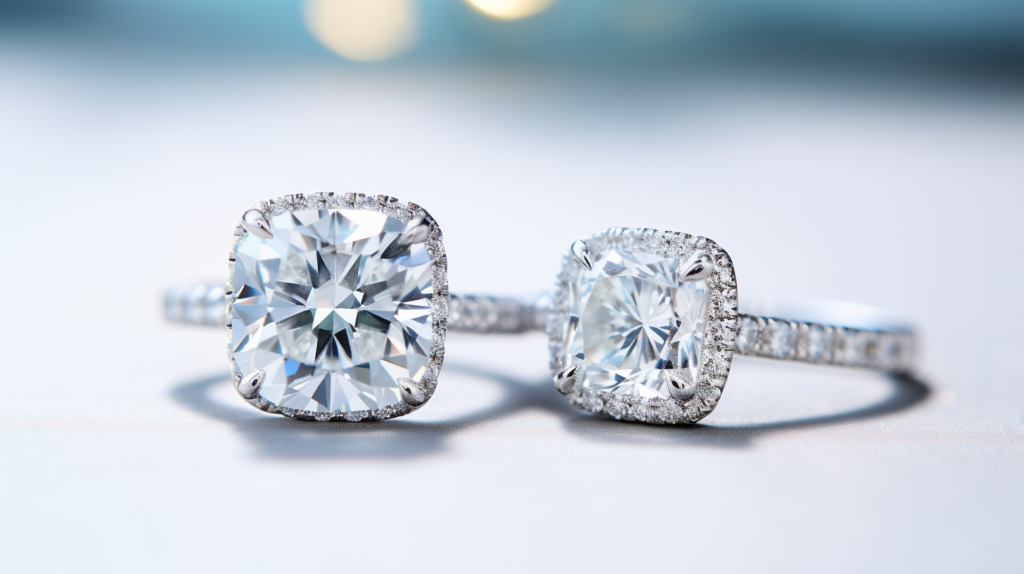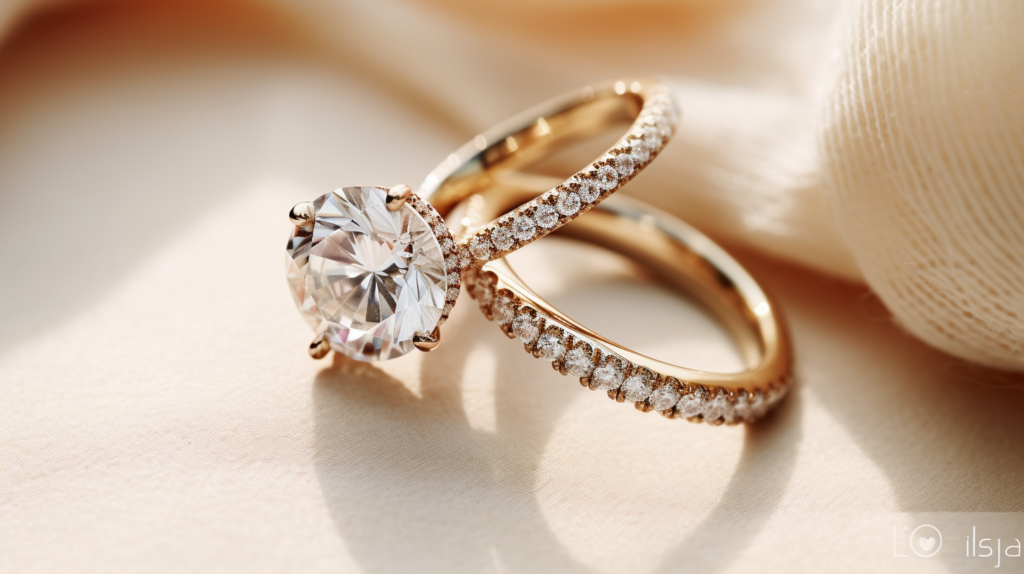Welcome to this informative diamond vs. moissanite post! As gemstone lovers, moissanite and diamonds have always appealed to us. This Brightguide article examines the intriguing similarities between these two beautiful stones.
Moissanite, a synthetic crystalline silicon carbide, is a popular diamond substitute. Despite its beauty, moissanite is different from diamonds in many ways. We’ll examine these gemstones’ unique qualities, from color to price to durability.
Related article: Cuts in a Diamond: A Comprehensive Guide
Key Takeaways
- Moissanite, a synthetic crystalline silicon carbide, is a popular diamond substitute with unique qualities compared to diamonds.
- The color grade is a significant difference between moissanite and colorless diamonds, affecting their appearance and value.
- Moissanite creates a “rainbow effect” due to its optical properties, while diamonds sparkle with bright white light.
- Moissanite generally has higher clarity than natural diamonds, making it a good choice for those who want flawless jewelry.
- When comparing durability, diamonds are harder than moissanite, but both are durable for daily wear, making them the hardest substances on earth.

What is moissanite?
Because of its face cut, Moissanite has different brilliance and fire than diamonds. Lab-made moissanite is a popular, cheaper diamond alternative. Although moissanite and diamonds sparkle, they are different.
Moissanite shines differently than diamonds due to its cut. It produces stunning rainbow-colored flashes. The increased brightness may make things look like disco balls to some. What about diamonds? They sparkle because they reflect light brilliantly, dispersively, and scintillatingly. Moissanite’s higher refractive index makes it shine brighter than diamonds.
Let us see the difference between diamonds and moissanite! As we compare moissanite and diamonds, we’ll discuss their color, diamond clarity, and size.
Don’t miss this: Channel Set Diamond Rings: The Complete Guide

Diamonds vs. Moissanite: What Sets Them Apart?
Diamonds and moissanite are two gemstones that are becoming more and more popular these days. They would both make great stones for jewelry. Moissanite, which is sometimes called a “diamond simulant,” is one of the most popular choices for everyday wear.
The main differences between moissanite and traditional diamonds will help you make an informed decision. We will look at the color grade, the optical and physical properties, and the clarity grade, among other things.
Color Level
The color grade of the material is one of the main differences between moissanite and colorless diamonds. Diamond-like moissanite stones may have small differences in color, but most of the time, they are very white.
Colorless diamonds are popular for their brilliant white color. They look clean and pure because they don’t have any yellow, brown, or grey. D on the diamond color scale means the stone has no color at all, and Z means it is light yellow or brown. A diamond close to the letter D is thought to be worth more.
In some lights, moissanites appear yellow or grey despite being colorless. The color is more noticeable with larger moissanite. For those who want a specific gemstone look, this color difference can be crucial. The color of a gemstone affects its appearance and value.
Let’s see their difference in brilliance.
The Brilliance
Moissanite is a type of gemstone that has amazing optical properties because of its bright shine and fire. It creates what is called the “rainbow effect,” which are bright flashes of colour that some people find cool. Diamonds, on the other hand, sparkle in a way that makes a bright white light. You can really tell a big difference in how your jewelry looks when these different optical properties are used on it.
The Clarity
As a rule, moissanite is clearer than other stones since it doesn’t have as many flaws and inclusions. Most of the time, the clarity grade is higher than that of a natural diamond. It’s a good choice for people who want a piece of jewelry that doesn’t have many flaws because of this.
Putting moissanite and diamond side by side helps explain their clarity:
| Moisannite | Diamond | |
| Inclusions | Moissanite made in a lab is usually perfect | Natural diamonds may have inclusions visible to the naked eye |
| Flaws | It can have inclusions or flawless, depending on the diamond. | Natural diamonds may have visible flaws. |
| Overall Clarity | Very high clarity, few flaws and inclusions | It can have inclusions or flawless depending on the diamond. |
Don’t miss this: Diamond Depth And Table: Everything You Need to Know
Engagement Ring Setting
Because they look good and don’t cost a lot of money, moissanite engagement ring settings are becoming more sought after. They’re good for couples on a budget because the price doesn’t go up too much when you use bigger center stones. Where you buy your moissanite engagement ring stones will have a big effect on how much they cost.
Fire and brightness
The fire and brilliance of moissanite are different from diamonds, giving it a unique look. Moissanite sparkles because it reflects white light. Moissanite sparkles more because it bends and spreads light.
Diamonds reflect light brilliance, dispersion, and scintillation. This makes diamonds shine. While diamonds sparkle, moissanite is more beautiful and lively due to its higher refractive index. Diamonds can be included or flawless, but moissanite is usually clear. Consider this clarity difference when choosing between the two gemstones. Find out which gemstone lasts longer.
The Carat
A 1-carat diamond is roughly equivalent to a 6.5mm moissanite, while a 2-carat diamond is about equal to an 8.5mm moissanite. Engagement Ring with 2.3 Carat Round Diamond and 2.2 Carat Round Moissanite in a Double Signature Wrap Setting When choosing a center stone for an engagement ring, cost should be a primary consideration.

Which lasts longer?
When comparing durability, moissanite and diamond Mohs hardness is important. Diamonds were the hardest mineral ever discovered, at 10. Moissanite, at 9.25, is the next hardest mineral. Diamonds are more durable than moissanite and less likely to chip or scratch. However, both gemstones can withstand surface scratching and are durable, and can be worn daily. This makes them the hardest substances on earth.
Check this out: Color Vs Clarity: What Matters More
Moissanite vs. Diamond: Cost and Size
As diamond experts in the diamond industry, we conclude that moissanite costs much less than a diamond of the same size. This makes it an affordable alternative to diamonds. Knowing what someone needs and why they want gemstones is crucial. Silicon carbide moissanite is a beautiful, affordable diamond alternative.
Diamond prices depend on cut, clarity, carat, and other factors. The price of moissanite stones depends on their size and shape. Moissanite is cheaper due to supply and demand. Engagement rings with diamonds remain popular.
Moissanite offers larger stones at lower prices. A one-carat moissanite costs under $1,000, which is an affordable option. A diamond of the same size would cost at least $3,000 and have poorer color and clarity.
An interesting read: Diamond Culet: What You Need to Know

Beauty Made in a Lab or Natural Origin?
We prefer lab diamonds to natural origin. Lab-grown diamonds are real diamonds made in a controlled environment. They are chemically and physically identical to natural diamonds, making them a good choice for those who want a diamond without mining.
Lab diamonds are becoming more popular as an ethical and environmentally friendly choice. They look and act like real diamonds but are lab-grown. Lab-grown diamonds are as beautiful and high-quality as real diamonds but cause fewer ethical and environmental issues.
The Alternatives
As a natural moissanite is rare, there are other diamond alternatives aside from lab-grown diamonds and moissanite gems. These include lab-made cubic zirconia, white sapphires, and others. Diamond alternatives are as beautiful and sparkly as real diamonds but cheaper.
Silicon carbide stone called Moissanite resembles a diamond. Its bright sparkle and fire make it a popular alternative to diamonds. For budget-conscious shoppers who want a beautiful stone, moissanite is cheaper than diamonds.
Conclusion
if you are buying diamond engagement rings, moissanite gemstone is a good gemstone option due to its price, durability, and beauty. Moissanite is a perfect gemstone with some diamond-like qualities and others. The Mohs hardness scale rates moissanite 9.25, making it durable enough to wear daily. Diamonds are harder than other gemstones at 10. Both are sturdy and won’t chip or crack. But if you are on a tight budget, Moissanites is an excellent choice.
Sources
BrighterGuide is dedicated to providing accurate and relevant information as you explore the wonderful world of diamonds and jewelry. To this end, our writers refer to primary information sources in building each article that appears on this website. These include, but are not limited to, published news articles, government portals, research papers, and more.
- Gemological Institute of America. (n.d.). Gemological Institute Of America | All About Gemstones – GIA. https://www.gia.edu/
- International Gem Society LLC. (2022b, October 13). Birthstone Chart – Modern and Traditional – International Gem Society. International Gem Society. https://www.gemsociety.org/article/birthstone-chart/
- Learn How to Buy a Diamond with the GIA Diamond Buying Guide | 4Cs of Diamond Quality by GIA. (2022, July 22). GIA 4Cs. https://4cs.gia.edu/en-us/diamond-buying-guide/